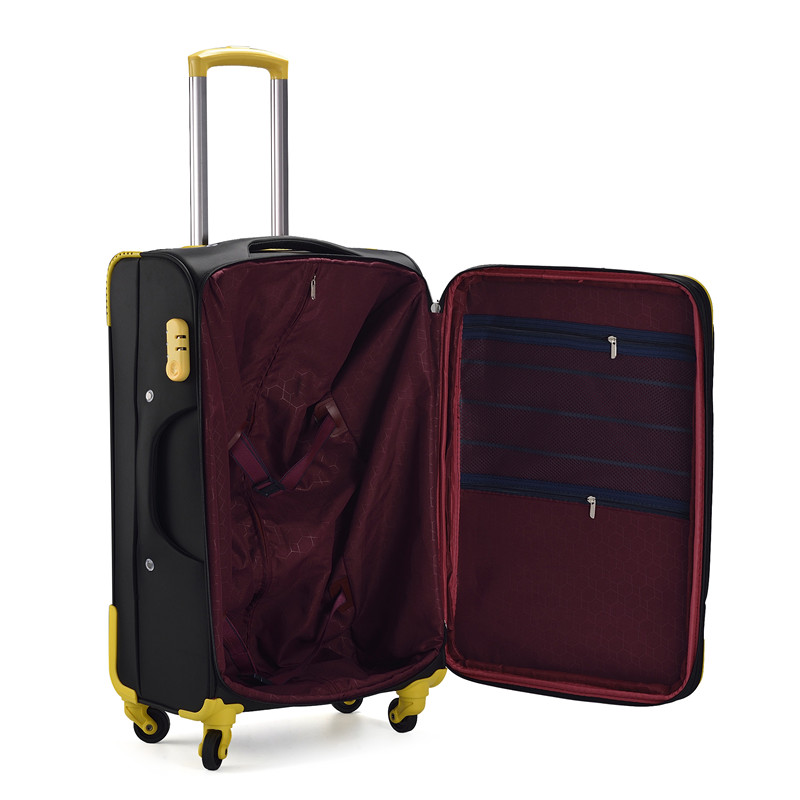RFID radio tags are actually printed on the road (below)
─ Dry Clamping Method- ─ Wafer clamping method- - Prevention of static electricity- - reading and identification- Source: Long Chen Printing Technology Network Huang Xiuchen A half pound lighter than max lite 4, this lightweight 25 inch spinner maximizes your packing power and is the ideal checked bag for medium to long trips
Limited Lifetime Coverage plus trusted companion promise, which covers the cost of repair for damage from airline or other common carrier for 1 year
Three piece luggage in one set with 20 inch,24 inch,28 inch upright,can be stored one into another.
This dry clamping method requires a more sophisticated and complicated operating system because it needs to cut the wafer on the precise position of each label. <See Figure 5> 
If it is to be delivered in rolls, it requires a local gluing machine and its position must also be very accurate.
This is a method of clamping a UHF tag. The antenna is printed on the back of the label and then glued because the conductive ink cannot be printed on the adhesive surface of the sticker. <See Figure 6> 
There is a printed antenna solution that uses a single layer of material and then double-sided gluing. The label pattern is printed on the front and the antenna is printed on the back. Conductive glue is sprayed on two antennas. The wafers continue to advance with the roll insertion system and are coated with glue.
Each wafer of the alignment mark synchronized with the print pattern is cut and aligned with the antenna to accurately press the electrically conductive adhesive on the roll. The adhesive ensures that the wafer is securely rolled into the heat curing oven to permanently bond the wafer and antenna together. Then apply a continuous hot melt adhesive of full width on another rolled-up release roll. The release paper is attached to the back of the label in a cold transfer adhesive, and the RFID label is completed.
Another way is to use pressure sensitive self-adhesive stickers (see Figure 7). After the printing pattern, the release paper is first degummed. The fuse that receives the conductive ink is made with a partial squeegee and the antenna is printed on this fuse. 
The process of inserting the chip into the antenna has been previously described. The antenna is precisely positioned to be hot melt offset on the release paper, and then the hot melt is transferred to the antenna in a cold manner when the release paper is rewound.
Electrostatic elimination (ESD) is the most difficult part of the RFID process. When the high-ESD ESD is introduced, the micro-complex circuit of the wafer may be destroyed.
Before the RFID chip is installed in the circuit, ESD is very easy to damage it. After installation, it will be relatively protected. After installing the antenna, it will be relatively harmless because of the circuit. There is no security concern after becoming a sticker.
Therefore, it must be transported in electrostatically-eliminated packaging until it is placed in the insertion equipment. It also strictly requires that it be handled in accordance with the manufacturer's instructions. It is usually handled by a technician wearing a strap type grounding wire and avoids direct Touch with your hand.
The printing processing machine is very easy to generate static electricity. When the roll material rubs against the air or passes through the press roller and the drive roller (especially rollers without a metal surface, and ungrounded rollers), it will also be unglued and re-glued. occur.
ESD is most likely to occur when the air is dry and the film is printed. Therefore, the web printing machine must be strictly required to install the ESD static elimination management control device.
An RFID reader is a machine capable of reading, writing, and writing, and must be of the same frequency and specification as an RFID tag. A reader is used during the installation to test the function of the tag. This test ensures smooth mass production and early detection of damaged wafers.
There are many different identification strategies, from simply reading faulty tags to writing special designs and reading information about valid ranges from various levels.
From writing to reading, it can be done in seconds to recognize a tag to get all the information. This is really a great new impact on computer processing operations.
4 wheel spinners rotate 360 degree for a smooth roll. Lightweight, sturdy PowerScope handle stops at 38 inch and 42.5 inch features a patented contour grip with rubberized touch points for easy maneuvering. Unique bottom tray design increases durability
Expands up to 2 inch to maximize packing capacity. Features low profile top, side and bottom carry handles, two exterior compartments, full length interior lid pocket, side accessory pocket and adjustable hold down straps for packing convenience
better than polyester material ,the luggage is made of 1680D oxford cloth. 210D nylon lining
Four multi-directional spinner wheels and Telescopic Handle for easy mobility.

Canvas Luggage,Canvas Luggage Bag,Canvas Trolley Bag,Best Canvas Luggage, cheap trolley bags, travel luggage bag, waterproof travel bag
Zhejiang Yinglin Luggage Co. Ltd , https://www.yllcluggage.com
